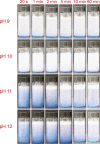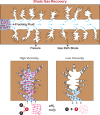Supramolecular dynamic binary complexes with pH and salt-responsive properties for use in unconventional reservoirs
- PMID: 34855902
- PMCID: PMC8638876
- DOI: 10.1371/journal.pone.0260786
Supramolecular dynamic binary complexes with pH and salt-responsive properties for use in unconventional reservoirs
Abstract
Hydraulic fracturing of unconventional reservoirs has seen a boom in the last century, as a means to fulfill the growing energy demand in the world. The fracturing fluid used in the process plays a substantial role in determining the results. Hence, several research and development efforts have been geared towards developing more sustainable, efficient, and improved fracturing fluids. Herein, we present a dynamic binary complex (DBC) solution, with potential to be useful in the hydraulic fracturing domain. It has a supramolecular structure formed by the self-assembly of low molecular weight viscosifiers (LMWVs) oleic acid and diethylenetriamine into an elongated entangled network under alkaline conditions. With less than 2 wt% constituents dispersed in aqueous solution, a viscous gel that exhibits high viscosities even under shear was formed. Key features include responsiveness to pH and salinity, and a zero-shear viscosity that could be tuned by a factor of ~280 by changing the pH. Furthermore, its viscous properties were more pronounced in the presence of salt. Sand settling tests revealed its potential to hold up sand particles for extended periods of time. In conclusion, this DBC solution system has potential to be utilized as a smart salt-responsive, pH-switchable hydraulic fracturing fluid.
Conflict of interest statement
The authors have declared that no competing interests exist.
Figures








Similar articles
-
Complex Fluids and Hydraulic Fracturing.Annu Rev Chem Biomol Eng. 2016 Jun 7;7:415-53. doi: 10.1146/annurev-chembioeng-080615-033630. Epub 2016 Apr 6. Annu Rev Chem Biomol Eng. 2016. PMID: 27070765 Review.
-
pH-responsive viscoelastic supramolecular viscosifiers based on dynamic complexation of zwitterionic octadecylamidopropyl betaine and triamine for hydraulic fracturing applications.RSC Adv. 2021 Jun 25;11(37):22517-22529. doi: 10.1039/d1ra00257k. eCollection 2021 Jun 25. RSC Adv. 2021. PMID: 35480416 Free PMC article.
-
High-Temperature-Resistant, Clean, and Environmental-Friendly Fracturing Fluid System and Performance Evaluation of Tight Sandstone.J Environ Public Health. 2022 Aug 3;2022:5833491. doi: 10.1155/2022/5833491. eCollection 2022. J Environ Public Health. 2022. Retraction in: J Environ Public Health. 2023 Oct 11;2023:9848042. doi: 10.1155/2023/9848042. PMID: 35967475 Free PMC article. Retracted.
-
Effect of maturity and mineralogy on fluid-rock reactions in the Marcellus Shale.Environ Sci Process Impacts. 2019 May 22;21(5):845-855. doi: 10.1039/c8em00452h. Environ Sci Process Impacts. 2019. PMID: 30840020
-
A Critical Review of the Physicochemical Impacts of Water Chemistry on Shale in Hydraulic Fracturing Systems.Environ Sci Technol. 2021 Feb 2;55(3):1377-1394. doi: 10.1021/acs.est.0c04901. Epub 2021 Jan 11. Environ Sci Technol. 2021. PMID: 33428391 Review.
References
-
- Ren L, Lin R, Zhao J, Rasouli V, Zhao J, Yang H. Stimulated reservoir volume estimation for shale gas fracturing: Mechanism and modeling approach. J Pet Sci Eng. 2018;166: 290–304.
-
- Hu X, Wu K, Li G, Tang J, Shen Z. Effect of proppant addition schedule on the proppant distribution in a straight fracture for slickwater treatment. J Pet Sci Eng. 2018;167: 110–119.
-
- Chun T, Li Y, Wu K. Comprehensive experimental study of proppant transport in an inclined fracture. J Pet Sci Eng. 2020;184: 106523.
Publication types
MeSH terms
Substances
LinkOut - more resources
Full Text Sources

